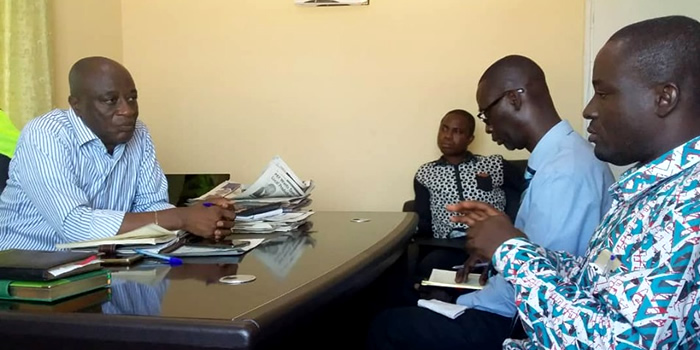

Agriculture
Agriculture which is the mainstay of the district economy employs about 77% of the labour force. The active male and female population percentage engaged in farming stand at 55 male and 45 female. There is however, no clear-cut distinction between farmers who produce either cash or food crops and farmers engaged in the production of food crops and rearing of livestock, poultry and fish farming.
There are four (4) operational zones with regard to Agricultural Extension work. There are only five (5) Extension Officers in the District. This gives an extension officer farmer ratio of 1:10,127 compared with an ideal national standard of 1:300 which militates against good agricultural practices.
There are four main ways of land acquisition identified in the District, namely; Individual, family means, outright purchase and abunu or abusa. The average farm size in the district is estimated at 5.3 acres. The district does well in food crops like cassava, cocoyam, maize, plantain, yam and vegetables. Production of cash crops such as cocoa citrus and oil palm is dominant.
COCOA
Production of cocoa is dominant in the district. It substantially employs greater number of people in the district. Cocoa grown areas in the District are Koben, Boasewa, Anunu, Asilivikrom, Bukuruwaso, Duapompo. Intensification of the cocoa mass spraying exercise will help improve cocoa yield which would go a long way to help achieve the national target of 1million tonnes in 2018.
OIL PALM
Oil palm production is also carried out by most farmers and serves as food and cash crops. Oil palm production in the District is high and in an investment potential for the government’s flagship programme of One District, One Factory (IDIF). Production is done on large scale in the District and that raw materials are readily available to supply palm oil extraction or soap making factory investments in the District.
C A S S A V A
It is widely grown and it has comparative advantage over other food crops. It is sold in its raw form or processed into gari. The Department of Food and Agriculture has introduced the high yielding varieties like Afisiafi, Abasafita and Tecbankye through the efforts of the P.S.I on cassava. Areas where cassava is grown in the District include Bokor, Dasubinmadweni, Ansa, Anitoa, Anhwiam.
C I T R U S
Most farmers around Akromaso, Nyamekrom, Pewodie, are well known in citrus production. The name ‘Obuasi Ankaa woo’, is associated with oranges from these communities. About 70% of oranges produced in the district are from these areas. Efforts are being made by the District Directorate of Agriculture to bring the farmers together under one umbrella. The farmers could source for funds to establish an orange processing plant, to produce fresh juice for sale. It is envisaged that patronage will be very good as the area is already known for its sweet and good quality oranges. This will also go a long way in creating employment and reducing poverty.
M A I Z E
Production of maize is not being fully exploited. Farmers prefer the cultivation of local varieties to the improved varieties like obaatampa and mamaba which yield higher and have high protein content than the local varieties. Maize production has seen a tremendous boost with the inception of the ‘Planting for Food and Jobs programme’. In 2017, the total area cropped under the ‘Planting for Food and Jobs programme’ is 790 hectares with and average yied of 2.5mt/ha and an estimated production of 1,975 metric tonnes. Areas where maize is grown on a large scale include Akwansrem, Pipiiso, Konsa, Nyamkomase.
P L A N T A I N
Production of the crop is on the increase due to high demand and ready market. Apem, Oniaba, Asamienu and Apantu are the Common varieties produced by farmers. Communities where plantain is widely grown include Appiah Nkwanta, Kwabena Fante, Saponso, Sakete, Nyamenaose.
V E G E T A B L E S
Vegetables are mostly grown during the dry season (Nov – March) Farmers, however, face water problems since there are no irrigation facilities, even though some rivers in the district are perennial. Some vegetables grown in the District are cabbage, tomatoes, pepper, garden eggs and okro.
AGRO – CHEMICAL SHOPS (BANNED CHEMICALS)
Currently agro – chemical shops are being opened in Asokwa and Fumso to boost agricultural activities. This is due to the fact that farmers are catching up with the education on NO-TILLAGE by the District Directorate of Agriculture. Due to the high cost of farm labour, farmers now use these chemicals (weedicide) as an alternative for weed control. The District Directorate of Agriculture also makes regular checks, so that all banned chemicals are not sold to farmers.
Some Banned chemicals are;
• D.D.T
• All types of urden
• P.P. Kumakate
• Phiostexin for maize storage
F O R E S T R Y
The district has some forest reserves namely Fum headwaters, Dampayaw forest reserve which are rich in timber and other forest resources, especially medicinal plants. Besides these forest reserves, large portions of the secondary forest in the district are being cultivated into teak and rubber plantations.
L I V E S T O C K
Majority of the total farming population are engaged in crop production to the detriment of livestock farming which is poorly patronized. It is estimated that about 15 percent of the farming population are into livestock production. The farm animals mainly cattle, sheep, goat and grasscutter are produced in small scale levels.
The average stock of sheep and goats per household is between 10 – 20.
P O U L T R Y
Commercial poultry farming is on the increase. The commercial poultry farmers use deep litter system technology, whilst the local birds and small ruminants are on the free range. Low level in the livestock production is due to high incidence of diseases and pest associated with the rain forest ecology coupled with the fact that there is only one Veterinary Technical Officer in the district.
Diseases such as Rabies, worm infestation, PPR and CBPP in cats, dogs, sheep, goats and cattle and poultry diseases need the attention of qualified veterinary surgeon and laboratory.
F I S H I N G
The low supply of fish in the district is due to lack of inland fishing. MOFA is however, making efforts to encourage farmers to establish fish ponds to boost fish production in the district.
Special/Flagship Programmes
Planting for Food and Jobs Programme
It was launched on Wednesday, 19th April 2017 at Goaso in Brong-Ahafo Region. The programme seeks to increase the production of maize by 30%, rice by 49%,soyabean by 25% and sorghum by 28% from current production levels nation-wide. It also seeks to encourage the youth to desist from migrating to urban centers in search of non-existent jobs. The Government of Ghana has reduced the prices of fertilizer by 50% to ensure the success of the programme.
The Government of Ghana intends to construct 1,000 metric ton capacity warehouse in each District to store the surpluses under the ‘Planting for Food and Jobs’ programme.
The crops and vegetables grown under the ‘Planting for Food and Jobs programme’ in the District are maize, rice (paddy), tomatoes, pepper and cabbage. In 2017, a total of 1,097.2 hectares of land were cropped under the programme with an average yield of 95.5mt/ha and an estimated production of 6,689metric tonnes. Maize had cropped area of 790ha with an average yield of 2.5mt/ha and an estimated production of 1,975metric tonnes.
Rice (paddy) had cropped area of 180ha with an average yield of 5.0mt/ha and an estimated production of 900metric tonnes. Tomatoes also had cropped area of 66ha with an average yield of 37mt/ha and an estimated production of 2,242metric tonnes. Pepper had a total cropped area of 30ha with an average yield of 16mt/ha and an estimated production of 480metric tonnes. Moreover, cabbage had cropped area of 31.2ha with an average yield of 35mt/ha and an estimated production of 1,092metric tonnes.
The District Agricultural Directorate (DAD) received 2,810 fertilizers with NPK fertilizer being 1,550 and Urea 1,260 in 2017 under the programme and distributed 1,540 fertilizers with NPK fertilizer being 998 and Urea 542 to three Hundred and ten (310) beneficiary farmers with 288 males and 22 females. Table 1.27 Shows performance of Planting for Food and Jobs (PFJ) in 2017.
Date Created : 2/14/2019 3:44:45 AM







 facebook
facebook
 twitter
twitter
 Youtube
Youtube
 +233 593 831 280
+233 593 831 280 0800 430 430
0800 430 430 GPS: GE-231-4383
GPS: GE-231-4383 info@ghanadistricts.com
info@ghanadistricts.com Box GP1044, Accra, Ghana
Box GP1044, Accra, Ghana